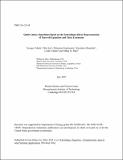| dc.contributor.author | Vahala, George | en_US |
| dc.contributor.author | Soe, Min | en_US |
| dc.contributor.author | Kououtsis, Efstratios | en_US |
| dc.contributor.author | Hizanidis, Kyriakos | en_US |
| dc.contributor.author | Vahala, Linda | en_US |
| dc.contributor.author | Ram, Abhay K. | en_US |
| dc.date.accessioned | 2025-03-21T20:22:23Z | |
| dc.date.available | 2025-03-21T20:22:23Z | |
| dc.date.issued | 2023-07 | |
| dc.identifier | 23ja024 | |
| dc.identifier.uri | https://hdl.handle.net/1721.1/158723 | |
| dc.description | Submitted for publication in IntechOpen | |
| dc.description.abstract | It is well known that Maxwell equations can be expressed in a unitary Schrodinger-Dirac representation for homogeneous media. However, difficulties arise when considering inhomogeneous media. A Dyson map points to a unitary field qubit basis, but the standard qubit lattice algorithm of interleaved unitary collision-stream operators must be augmented by some sparse non-unitary potential operators that recover the derivatives on the refractive indices. The effect of the steepness of these derivatives on two-dimensional scattering is examined with simulations showing quite complex wavefronts emitted due to transmissions/reflections within the dielectric objects. Maxwell equations are extended to handle dissipation using Kraus operators. Then, our theoretical algorithms are extended to these open quantum systems. A quantum circuit diagram is presented as well as estimates on the required number of quantum gates for implementation on a quantum computer. | |
| dc.publisher | IntechOpen | en_US |
| dc.relation.isversionof | doi.org/10.5772/intechopen.112692 | |
| dc.source | Plasma Science and Fusion Center | en_US |
| dc.title | Qubit Lattice Algorithms Based on the Schrodinger-Dirac Representation of Maxwell Equations and Their Extensions | en_US |
| dc.type | Article | en_US |
| dc.contributor.department | Massachusetts Institute of Technology. Plasma Science and Fusion Center | |
| dc.relation.journal | IntechOpen | |
